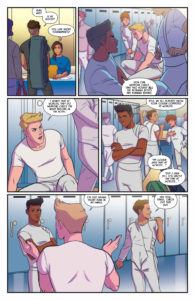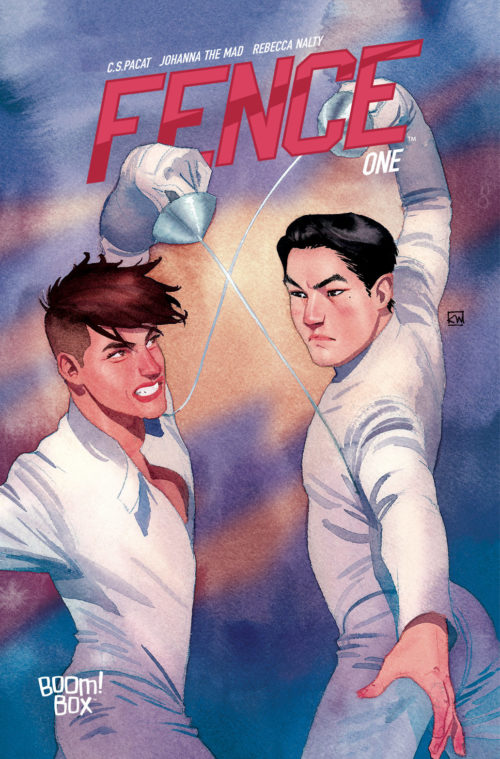
Rogues Portal had the chance to do a Q&A with the creative team for the upcoming series Fence which is out from Boom! Studios today. It is the first comicbook from both C.S. Pacat and Johanna the Mad.
Check out the interview below!

I can’t say that I know of any other comics that focus on the world of fencing. How did the concept of Fence come to fruition?
C.S. PACAT (CSP) : I got really into sports comics in Japan, where I lived for about five years. I love the intense rivalries, the striving, the way you can take characters to their breaking point. Haikyuu!! and Hikaru no Go are easily some of my favorite comics of all time. I was also really inspired by Ngozi Ukazu’s fantastic LGBT hockey web comic, Check, Please! and the joyously queer Japanese animation Yuri!!! on Ice. I started to wonder, what happens when all those intense energies come out in a combat sport?
I fenced épée all through high school, and thought it was the perfect sport for that kind of comic—it’s intensely strategic and psychological, a solo combat sport with a rich history. Fencing is also a sport famous for its striking visuals, its silhouettes, and its arresting lines. There was so much visual and storytelling potential—the concept started from there.
JOHANNA THE MAD (JTM): I joined the project when Cat had already planned and written a good part of the script, but I do know it partly originated from her love for the sport.
I guess one thing Cat and I have in common is that we create the content we want to see; I enjoy stories where the queer character isn’t just a sidekick but rather the main focus of the story. Plus, our interest in the sports genre in manga and anime makes Fence all the more amusing to us and a great feature to add so much weight to in a LGBTQ story.
Put on your best pitch-person hat for a moment and give me your best sales pitch for Fence.
CSP: Fence follows the rise of sixteen-year-old outsider Nicholas Cox in the world of competitive fencing, as he  joins the team at an elite boys’ school.
joins the team at an elite boys’ school.
Through clashes, rivalries, and romance between teammates, Nicholas and the boys of Kings Row must overcome a series of personal challenges to go from tryouts, to qualifying matches, and to the final, where they will unlock their potential, and Nicholas will finally face his rival.
It’s a story with powerful relationships, gorgeous visuals, intense competition, and characters I hope you’ll fall in love with as you journey into the world of fencing.
JTM: Fence is about both the heat of the sport and the power of deep bonds; you definitely can’t miss out! A unique story, diverse cast, romance, it’s got it all!
Warning: Too many great characters that will probably steal your heart.
Did you have any experience with fencing before Fence? What kind of research did you do?
CSP: I had stopped fencing by the time I went to university, but I went back to training recently in order to prepare for writing the comic. I also work with fencing coach and choreographer Pieter Leeuwenburgh to construct the fight scenes in the comics—as well as to develop the fencing strengths and weaknesses for each of the characters. Pieter’s one of Australia’s foremost épée coaches. We usually fence the choreography ourselves and then film it from multiple angles to provide an art reference for Johanna.
Ultimately, I wanted the fencing to feel as authentic as possible. I think part of the joy of a sports comic is the feeling of immersing yourself in a new world, with all its specificity.
JTM: This is my first time getting into fencing! I’ve watched the sport before but wasn’t really aware of the world behind it. I had to start from the very basics, understanding how it works, the rules, every element from the uniform, to certain techniques and poses, the ripostes, and so much more. Thankfully, Cat explained to me most of these things and is always there whenever I don’t know about something.
Being your first comic book series how has your creative process changed compared to other projects you have done?
JTM: I’ve had to become A LOT more organized. My process used to be quite relaxed in terms of deadlines and the number of hours I spent working, but now I know that, when drawing in comics, you need to create a schedule that fits you, doesn’t overwhelm you, and helps you being efficient. Otherwise, it won’t happen.
CSP: As a novelist, I think what surprised me the most was how economical a comic script must be. There’s nowhere to hide in a comic. There are places to hide in a novel. I suddenly understood, for example, the potential value of archetypes, which are a kind of shorthand in a medium where space is at a premium.
Writing comics has also helped my novel writing enormously, because it has unlocked a different way of visual thinking. It’s very tempting to think of a novel as having continuous action, like a film. But in fact, a novel is more like a comic—you do not describe the action continuously, you focus in on a few key visual to illustrate the scene. You give the illusion of continuity via a few carefully chosen frames. This laser-sharp focus on the choice of visuals in comics has helped me think about scenes in terms of: What are the key images? How can I hone them further, make each image the most powerful or iconic version of itself?
How did you collaborate on the series? Did one person take the lead or was it more of a back and forth?
JTM: I think it’s been more of a “miraculous” teamwork between us. Surprisingly, Cat and I have had the same vision for Fence since the beginning (before she told me where she intended to go with the story). I feel it’s safe to say we’re both in sync when working in this project. Every now and then we’d be squealing together about how we knew what the other one meant with their work in a certain scene or chapter; it’s amazing.
CSP: Initially—back when the comic was just a four-page pitch—I wrote the story outline and character profiles, and Johanna used them as the jumping-off point to create the first character sketches.
For some of the characters, like Seiji, there was a really specific look that I wanted us to achieve. For others, like Aiden, I left things totally open and Johanna came up with something amazing. She is so good at characterization—at making characters seem so utterly themselves. I think we both instantly clicked into each other’s vision, so that it felt collaborative from the beginning.
We then worked together to come up with elements of world building like the school uniforms and the locations, while BOOM!’s amazing designer, Marie Krupina, developed the school logos.
The way we work currently, I write the scripts, and Johanna transforms them into wonderfulness—she has this ability to capture iconic moments and find amazing angles and ways of looking at things. We then back-and-forth to get the beats and the character notes exactly right. My favorite parts of working on the comic are the moments when it is most collaborative, when I can riff ideas off Johanna’s amazing artwork, or when we are chatting about characters or upcoming ideas.
Without giving away any spoilers what can you tell us about some of the characters we are going to meet?
Here’s a sneak peek of the roster!
 Nicholas Cox is the illegitimate son of Olympic fencing champion Robert Coste. He grew up in rough circumstances, isn’t great with authority figures, is often in detention, but is drawn to fencing, and displays raw natural talent.
Nicholas Cox is the illegitimate son of Olympic fencing champion Robert Coste. He grew up in rough circumstances, isn’t great with authority figures, is often in detention, but is drawn to fencing, and displays raw natural talent.
His rival is Seiji Katayama, a fencing prodigy who has been training since the age of six. Seiji’s excellence isolates him from others, and he has lived a life devoted only to fencing, spending little time with peers, until he meets Nicholas.
Harvard Lee is the team captain with a heart of gold. No one can understand how he’s friends with a guy like Aiden, but the two have been BFFs since childhood. Aiden Kane is the school playboy, way too rich and good looking for his own good. (Don’t fall in love with him, he’ll break your heart.)
Eugene Labao is the jock determined to make the team this year, after two failed attempts. He won’t give up on his dream. Bobby Rodriguez is shy but very sweet natured. He’ll get up the courage to talk to Seiji someday.
Dante Rossi has zero interest in fencing, and has to put up with everyone else being obsessed with it.
They’re all coached at Kings Row by Sally Williams, a former champion fencer who has a lifelong rivalry with Alessandra Donati, the coach of Exton, their rival team.
JTM: I’ll tell you about my favorites!
Nicholas is this unruly kid who is constantly left out; he wants to show he’s not what everyone thinks of him and plans to do so by becoming the best fencer.
Bobby is a sweetheart! He’s incredibly cute, cheerful, and, in my opinion, very likable. He’s the one I’m most excited for everyone to see.
Harvard is the captain of the team and, as such, 101% dependable. Along with his good looks, Harvard has an awesome personality which is what helps keep all these fencing boys in line.
The cast of characters is obviously diverse in several ways, can you speak to why you think diversity matters in comics?
CSP: I think diversity is important in all walks of life, but comics and genre fiction are the place where our modern-day mythmaking happens, where we often create and define what it means to be a hero. Opening up and diversifying heroic representation means that everyone has the chance to see themselves as a hero, to dream and aspire.
I think it was Junot Diaz who said that there’s this myth that monsters such as vampires can’t see themselves in mirrors, but in fact the opposite is true: It’s when you never see yourself reflected that you feel like a monster. And when you experience heroic representation for the first time, it’s utterly exhilarating—as so many women learned while watching the Wonder Woman movie, breaking into tears at the Amazons storming the beach, or Diana going over the top into No Man’s Land.
I know that for me, as a queer kid growing up, there were so few heroic queer characters that I remember how I clung to each one, rereading the tiny handful books or manga I could find with queer protagonists over and over again. So, I want to make a heroic landscape that has the same vibrant diversity as I see in the world around me—that is, for example, racially diverse and exuberantly queer.
JTM: I think it just feels awesome when you find characters that you can relate to in certain aspects, be it their way of thinking, gender, nationality, age, sexuality, even their backstory! I believe that’s how the reader starts to create a connection with the story in a comic and feel like they’re part of it, too.
As an artist and creator, one of my goals is to make sure there are more (good) like this out there for people who, like myself, are looking to identify with.
What skills from your work outside of the comic book world were helpful in creating the series?
JTM: My number one would be mastering the design of a character in order to make them look like themselves and not a completely different person every time. Most of my work consists of fan art which, in my case, can be translated to drawing the same characters over and over again. This has been very helpful because I’ve learned to pay attention to details and practice regularly to have a more consistent style.
CSP: The five years I lived in Japan opened my eyes to new ways of telling stories. It taught me that there were untapped markets for comics, entire genres and readerships that could potentially connect, but that Western comics largely ignored. Sports comics are huge in Japan, for example, but there are few Western sports comics (Check, Please! a notable exception). Or, think of the sheer size of the shoujo manga market in Japan, yet we don’t really have anything like that here. I think without my time in Japan, I wouldn’t have been able to vision Fence. That’s one reason why one of the two leads in Fence is Japanese: I gained so much artistically from my time there, it felt appropriate to include and celebrate a Japanese protagonist.
Are you athletic yourself? Are there any sports you excel or excelled at?
CSP: I’m really sporty, but prefer individual sports. I love combat sports and fenced in high school, then  switched to tae kwon do at university. I earned a black belt, but gave up TKD when I moved to Japan, in favor of trying out some Japanese martial arts like karate and judo.
switched to tae kwon do at university. I earned a black belt, but gave up TKD when I moved to Japan, in favor of trying out some Japanese martial arts like karate and judo.
These days I do fencing and figure skating, and horse riding when I can get the time to get out to the country and ride. I’m interested in jujitsu just because it’s so dominant in MMA right now, but don’t have time to pick up a new hobby. Ironically, I hate going to the gym, jogging or any kind of repetitive workout! I prefer exercise to be combined with something fun, or to include learning and honing a skill.
JTM: Not at all! I’m not really into practicing sports myself. I prefer watching the experts or reading manga about it. I’ve always loved swimming, though! I used to take classes when I was a kid and was pretty good, actually.
What comics, books, tv shows, or movies are you enjoying right now?
CSP: I’m loving the volleyball sports manga Haikyuu!!, as well as the LGBT hockey webcomic Check, Please!.
The TV highlight of the year for me was Yuri!!! on Ice, a joyfully queer anime about figure skating. And I just finished the most charming fantasy YA novel, In Other Lands by Sarah Rees Brennan, a magical school story with a wonderful bisexual protagonist.
JTM: At the moment, I’m in love with DreamWorks’ Voltron: Legendary Defender, Stranger Things, and getting a bit into the Outlander series.
As for comics, I just recently started reading it but I really like Rat Queens by Kurtis J. Wiebe.
Any plans for future projects that you can share?
CSP: My next project will be a YA novel, a fantasy with lots of magic and really intense relationships between characters. But I’d love to do more in the comic world, and ideas are percolating. Stay tuned!
JTM: I’m currently considering releasing my own comic, though it’s still a work in progress. We’ll see what happens!
Where can fans of the series check out any of your previous work or reach you?
CSP: Readers can check out my previous work on my website at www.cspacat.com, or reach me on twitter (@cspacat) or instagram (@c.s.pacat).
JTM: I post all of my work on my page johannathemad.com and social media: Instagram, Twitter, and Facebook with the username @johannathemad.
Finally, one word that describes your experience so far with Fence?
CSP: Exhilarating!
JTM: Dreamlike!
—
As you can tell, the team is super excited for Fence. Check back at noon today for a full review of Fence #1.


![[REVIEW] ‘BOSS LEVEL’ lS A FUN TAKE ON THE GROUNDHOG DAY SCENARIO](https://geekd-out.com/wp-content/uploads/2021/03/MV5BNTNhOWQ3ZDktMjgyMi00YTE2LTgwMzItNDFlM2Y0ZTE5ZDUxXkEyXkFqcGdeQWFybm8@._V1_-150x150.jpg)
